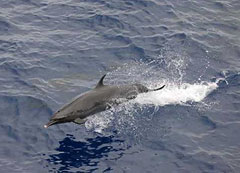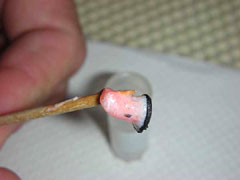

 | |||||||
|
|
Journals 2007/2008Heather Judkins
November 15, 2007 One of the goals of the STAR-LITE cruise is to collect, when possible, biopsy samples from the dolphin and whale species that we come across during the ship transects. The samples are conducted to gather genetic information about the various schools of dolphins and whales in the Eastern Tropical Pacific that may be impacted by the tuna fishery in the area. The primary samples taken are ones that are directly impacted by the fisheries. The secondary samples are ones taken of "species of interest" such as blue whales, beaked whales, fin whales, and humpback whales. In a previous journal entry, I explained how the samples are taken. There are scientists that are positioned at the bow if the schools are coming close to the ship with crossbows and the biopsy darts. I got to see them in action! We had a large school of approximately 40 spotted dolphins which were bow riding, giving the scientists as great opportunity to gather a biopsy sample. There was a scientist on either side of the bow taking aim at the dolphin as they came to the surface. Juan Carlos was successful! He got the sample back onboard and continued attempts for another sample. The process is pretty tricky because the ship is moving, the animals are moving, as well as the wind blowing. All things need to align to collect the samples. The dolphin in this area are not "fond" of large ships because of the tuna boats so when one gets close, the challenge begins!  The school of dolphin finally drifted on their way and he took the sample into the wet lab to prepare for future study on shore. He took the sample, put it in a small vial and stored it in a freezer which is kept at -80 degrees C which will keep the DNA in the sample from denaturing before we get it back to land.  This was the first one taken during this leg and it was great to be able to witness it! Marine Science Questions: 1. What can DNA samples tell us about the dolphins in this area? 2. Compare and contrast the spotted dolphin in the ETP to the bottlenose dolphins that are in the Gulf of Mexico. |
||||||